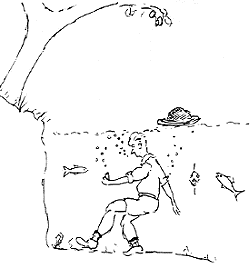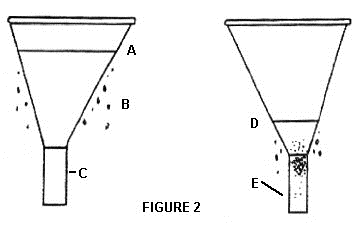Collecting Freshwater Life
by William Ells
Coniferae, Walnut Tree Lane, Loose, Maidstone, Kent. ME15 9RG.
 How NOT to collect freshwater life. My
wife and I were walking a farm trail at Marden, Kent. A mixed
farm with hops, fruit and sheep and a plantation of Salix
alba a cultivar coerulea or cricket bat willow. At
one point it passes close to the river Beult. I decided I would
collect some water although I had set out with no intention to
collect and did not have my rod and net with me, but I usually
have a tube or two in my pocket.
How NOT to collect freshwater life. My
wife and I were walking a farm trail at Marden, Kent. A mixed
farm with hops, fruit and sheep and a plantation of Salix
alba a cultivar coerulea or cricket bat willow. At
one point it passes close to the river Beult. I decided I would
collect some water although I had set out with no intention to
collect and did not have my rod and net with me, but I usually
have a tube or two in my pocket.
Going down to the water edge I
filled one of the little tubes, turned to come up the bank when
my feet started to slip into the water, thinking I would go in up
to my knees I was surprised to find myself going right under.
When I came up I found the water was chest high and my straw hat
was slowly floating away. I grabbed my hat and passed it to my
wife who then helped me out of the river and up the bank.
I stripped off my shirt and
shorts, my wife wrung out my shirt and I did the same with my
shorts and put them back on. My shirt felt too clammy to put back
on so we walked on a short distance to an open field where I hung
my shirt on a tree branch and sat in the sun to dry out.
Fortunately it was a warm day.
A note or two on a better way
to collect may not come amiss. Nearly every introductory book on
algae and protozoa has some instructions on collecting. There is
a very comprehensive account on collecting Rotifera by Eric
Hollowday in Microscopy (Journal of the Quekett Microscopical
Club) 1985, Vol. 35, part 3, which also applies to other forms of
microscopic aquatic life.
Collecting Net
Some years ago a friend kindly
gave me a small net with a collecting tube. I bought an anglers
extending landing net rod which extends to about 7 feet, made a
frame of wire four inches square on which to fit the net, fitting
same to the end of the rod with a screw clip of the type used to
fit rubber tubes on car radiators. I have found this very useful
although the mesh, screen printers 'silk', has apertures of about
100 microns, twice that recommended by Hollowday, as you may lose
very small forms through the mesh.
I have since been given a
wooden rod and net said to have been supplied by Watsons. The rod
is just under 3 feet long with a six inch diameter brass ring
with a screw fitting to the end of the rod. The net, with
apertures of about 90 microns was perished so I have replaced
this with a net of screen printers fabric as above, using the
original tube. See sketch of net and tube (Figure 2, after
Hollowday).
Collecting
For plankton organisms, the net
is immersed and 'figures of eight' described in the water,
keeping the net moving all the time. When the net is removed from
the water it is allowed to drain, the water and organisms which
do not pass through the net will fall into the tube which is then
emptied into a larger vessel (jam jar will do). Unwanted macro
organisms can be removed if the tube is emptied into a coffee
strainer placed across the top of the jar.
 KEY:
KEY:
A), D) Water level in net
B) Water draining through net
C) Plastic tube looks clear
E) Concentrated organisms falling into tube
Diatoms and Desmids can be gathered by scraping the edge of the
net up some stems of water plants and passing through any growth
of filamentous algae. If you are using a square net try passing
it gently along the bottom of small pools, some of the submerged
filamentous algae that can be reached from the bank can be
collected and put into a plastic bag.
In boggy areas the water from a
little of the wet moss can be squeezed into a collecting tube or
a little put into a plastic bag and sealed for later examination.
NOTE: it is not necessary to take large quantities of water or
moss, better to take a little from several sites. If you have a
good collection it will take hours to examine 100ml. of water
under the microscope if you make the effort to identify all the
organisms you find.
Comments to Bill Ells welcomed.
Editor's note
The Micscape Editor thanks William Ells for contributing this
article, which first appeared in Balsam Post the quarterly
magazine of the Postal Microscopical Society, UK. Note that Bill
Ells has written a number of articles on desmids which are an
attractive and fascinating algae, including an Introduction
to the Desmids. All
these articles can be found in our Articles
Library in the
Pond-life section.
© Microscopy UK or their
contributors.
Please report any Web problems
or offer general comments to the Micscape Editor,
via the contact on current Micscape Index.
Micscape is the on-line monthly
magazine of the Microscopy UK web
site at Microscopy-UK
WIDTH=1
© Onview.net Ltd, Microscopy-UK, and all contributors 1995 onwards. All rights
reserved. Main site is at www.microscopy-uk.org.uk with full mirror at www.microscopy-uk.net.
 How NOT to collect freshwater life. My
wife and I were walking a farm trail at Marden, Kent. A mixed
farm with hops, fruit and sheep and a plantation of Salix
alba a cultivar coerulea or cricket bat willow. At
one point it passes close to the river Beult. I decided I would
collect some water although I had set out with no intention to
collect and did not have my rod and net with me, but I usually
have a tube or two in my pocket.
How NOT to collect freshwater life. My
wife and I were walking a farm trail at Marden, Kent. A mixed
farm with hops, fruit and sheep and a plantation of Salix
alba a cultivar coerulea or cricket bat willow. At
one point it passes close to the river Beult. I decided I would
collect some water although I had set out with no intention to
collect and did not have my rod and net with me, but I usually
have a tube or two in my pocket. KEY:
KEY: